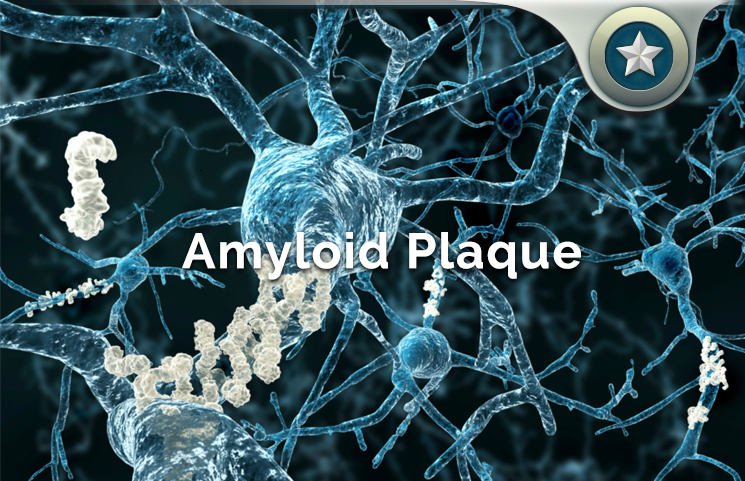Amyloid Plaque can be described as 1 of the 2 abnormalities in the brain which define the Alzheimer's disease (popularly known as AD). Technically, an individual may exhibit all the cognitive and behavioral symptoms of Alzheimer's disease, but if the brain lacks tangles and amyloid plaque then there is no actual diagnosis of the disease.
Amyloid plaque’s appearance in the brain precedes all the behavioral symptoms by several years. Amyloid plaque is essentially a sticky buildup that accumulates on the outside of the neurons or nerve cells. Amyloid itself can be defined as a protein that is usually found all over the human body.
The protein normally divides improperly in Alzheimer's disease, for reasons that are still unknown, to create a form referred to as beta amyloid that is toxic to the neurons found in the brain.
Beta Amyloid
The exact process of the formation of beta amyloid, as well as why it results in the death of cells, is still a mystery to date, but there are several possibilities that have been highlighted to that effect.
One possibility suggests that it may disintegrate into numerous fragments, thus releasing substances referred to as free radicals which in turn attack neurons in the brain. The second possibility is that beta amyloid creates small holes (channels) in the neuron membranes to allow for the influx of unlimited quantities of calcium.
Despite the fact that calcium in regulated quantities is necessary for normalcy in neuronal operation, excess amounts are known to kill neurons. Beta amyloid effectively kills neurons and plaques commence their formation. They are comprised of clumps of the amyloid protein and degenerating neurons.
The human body is incapable of breaking down such clumps and properly disposing of them. This is why they accrue in the brain. The plaques are normally the accumulation of small fibers referred to as beta amyloid fibrils.
Cause
A genetic abnormality called the apoE4 gene that has an implication in Alzheimer's disease may have some involvement in the production of amyloid plaque. This is because the gene may produce protein which attaches to the toxic beta amyloid, making it impossible for the human body to dissolve it.
This is the main reason why the beta amyloid that is toxic in nature accumulates in the brain as plaque. Similarly, molecules that are called free radicals may have a role to play in it. Usually, free radicals are known to play crucial roles in the human body like assisting the immune system in fighting off infections and diseases.
However, when the number of free radicals in the body becomes excessive then they begin to upset a neuron’s delicate balance. Nerve cells responsible for the production of beta amyloid are also likely to produce extra free radicals. This means that free radicals enhance the production of beta amyloid.
Dangers of Amyloid Plaque
There are several dangers that are associated with high amounts of amyloid plaque in the human brain, the notable ones include the ones listed below:
- It causes steep memory decline in individuals that are mentally healthy.
- It can result in cognitive impairment in people that are mentally healthy to the point that they experience difficulty in performing everyday tasks.
- It may cause memory diseases like Alzheimer's disease.
Amyloid Plaque Treatments
There are different treatment options that are now available for patients suffering from amyloid plaques. They include the ones outlined below:
Focused Therapeutic Ultrasound
This is a non-invasive ultrasound technology which functions to clear the brain of all structures related to the neurotoxic amyloid plaques which are accountable for the decline in cognitive function and memory loss in Alzheimer’s patients.
It beams sound waves into the tissue of the brain in a non-invasive manner. The sound waves oscillate at a super-fast speed to gently lay open the blood-brain barrier. The barrier is a layer which protects the brain against bacterial attack and instigates the microglial cells of the brain to become active.
Microglial cells are simply described as waste-removal cells that are capable of clearing out all the toxic beta-amyloid clumps which are attributed with the worst symptoms of Alzheimer’s disease. This treatment is effective and can almost guarantee restored memory function.
Aducanumab Treatment
Aducanumab is a new human monoclonal antibody that effectively reduces the quantity of the toxic beta-amyloid plaques in patients that have been diagnosed with early-stage Alzheimer's disease. A one year treatment using the Aducanumab antibody has been proven to slow down cognitive decline. It works by selectively binding amyloid plaques present in the brain. This allows microglial cells to dispose of the plaques.
The antibody has an impressive effect with amyloid plaque. However, patients should note that the outcome is heavily dependent on the duration of treatment and the dosage used. The higher the dose, the better the results will be. It is a perfectly safe treatment method because the antibody itself is of human origin. It is highly effective because of its ability to bond with beta-amyloid protein fragments that are abnormally folded.
Universal Plaque-Buster
This is a drug from NeuroPhage Pharmaceuticals. It is a protein that comes from a bacteriophage, and is a type of virus that specifically infects bacteria. The drug comprises of viral protein which recognizes common structural kinks shared by the misfolded proteins that are responsible for a number of brain diseases.
It is attached to the fragment of an antibody of human origin. The phage protein is what primarily binds to the plaque. Afterwards, the antibody marks it to be cleared from the patient’s brain.
Cannabinoids
Tetrahydrocannabinol (THC), as well as other compounds present in marijuana, promotes toxic amyloid beta removal on a cellular level. Cannabinoids have been found to be effective with regards to the removal of amyloid beta accumulation in the nerve cells. In research studies, THC significantly decreased the levels of amyloid beta protein and also eliminated the inflammatory nerve cell response which the protein causes.
Amyloid Plaque Conclusion
Alzheimer's disease can be categorized as a progressive brain disorder which results in the impairment of an individual’s ability to perform daily tasks and causes memory loss. One of the two main markers forthis didease is the accumulation of amyloid plaque, which also poses other dangers to the brain of a mentally healthy person.
Amyloid plaque can build up in the brain of almost anyone undetected before causing any symptoms, but it can be effectively treated using the methods outlined above.









